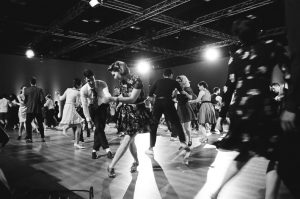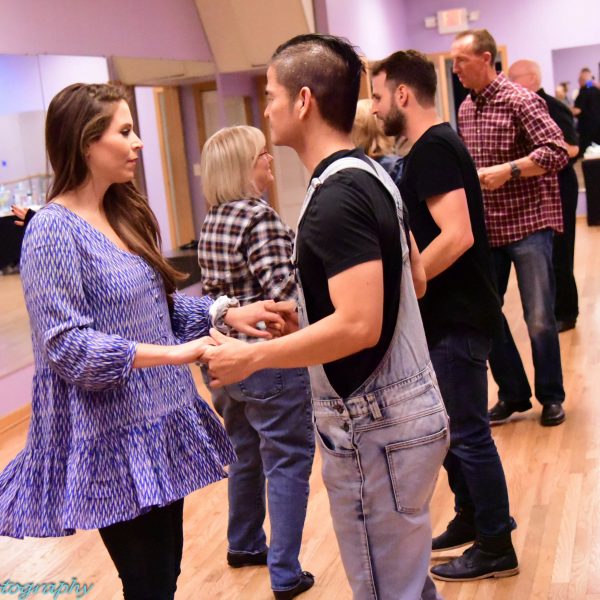Time and time again, I hear from my clients that they have no rhythm. Needless to say, I eagerly, yet happily, disagree with them because it is just not true – we all have a sense of rhythm! Our breathing, our heartbeat, both function around a set beat, or rhythm. With these automatic functions, it helps shed some light on the innate reasons why we are fascinated, captivated, and inspired by rhythm.
A fundamental part of understanding rhythm is the beat, which is the basic unit of time which dancers use to synchronize their movements to the music. Stringing together a myriad of beats is what gives rise to a tune’s rhythm, or the recurring pattern which we recognize as the backbone of any particular piece of music. Rhythm relates to many other musical concepts that you may learn about as you learn to dance, such as tempo, meter, and musicality. However for this blog post, I am just going to focus on what you need to know for keeping a rhythm while dancing!
- Counts
When discussing ballroom dance, it is helpful to know that each dance has its own unique rhythm,  which corresponds to the musical rhythm in different ways. In order to make sense of the rhythms in the various dances, we often label our movements by “counts”. Counts can be understood as the point at which the music and movements are explicitly synchronized. These counts often correspond directly to the timing of the music. For example, the meter of the Waltz is 3/3 and we count 1, 2, 3, and/or 1, 2, 3, 4, 5, 6. People sometimes comment that they can feel the counts of the music.
which corresponds to the musical rhythm in different ways. In order to make sense of the rhythms in the various dances, we often label our movements by “counts”. Counts can be understood as the point at which the music and movements are explicitly synchronized. These counts often correspond directly to the timing of the music. For example, the meter of the Waltz is 3/3 and we count 1, 2, 3, and/or 1, 2, 3, 4, 5, 6. People sometimes comment that they can feel the counts of the music.
However, feeling the counts and beats of a song, may not be as straightforward. Dances such as Swing or Foxtrot have a 4/4 timing but dancers may be using 6 count phrases. A count phrase can be described as counting up to 3, 6, or whichever predetermined number (Note: The numbers are determined by a single measure in a song, but we can discuss that another time!). Now you may be thinking How do you get 6 count phrases with only 4 beats?” Thankfully this video helps capture the concept of counting those bigger phrases within those 4 beats.
To help make the relationship even stronger between the music and movements, most high level dancers use both numerals and words to keep track of the timing, depending on the dance or even the specific step patterns or movements that they are working with. The words dancers use are slow and quick. The word slow (S) is worth 2 beats and the word quick (Q) is worth 1 beat. When we have a long series of “quicks”, we often count the dance numerically, in order to keep track of where we are in the rhythm.
And as a dancer, I think that one of the most fun things about Ballroom dance and Latin dance is the dances have different counts! And it presents that extra challenge!
Counting in Ballroom Dance
1. Waltz – 1,2,3
Waltz is not difficult to count to because both the steps and the music are grouped in even counts of three (3/4 timing). Remember though, that because there are an odd number of counts, you will start dancing each new bar on a different foot. Because of this, it is sometimes helpful to count two bars at a time (1,2,3 – 4,5,6), to give a sense of completion to each step. If the alternation of steps really throws you off, you can also “count” the foot alternation along with the rhythm as well. This would go : “left, right, left, right, left, right…” etc. until you get the alternating footwork sorted out.
- Check out an example here.
2. Fox Trot – S,S,Q,Q
Although Foxtrot music has 4 beats per bar, the basic dance rhythm is 6 counts long: S,S,Q,Q (remember “slows” are worth 2 beats of music). This means that a basic step takes 1½ bars of music (just like Swing). You can see below that although the beginning and end of the steps don’t always match the beginning and end of the bars, they do match up every 3 bars. More experienced Foxtrot dancers often use steps with alternative rhythms like the box step and chassés, to match the dancing to the music when it feels good to do so. The timing for box steps and twinkles are S,Q,Q. Because the musical phrasing is a little bit off from the rhythm of the steps, it’s best not to worry too much about always starting on the “1″ in the music, or always starting a new pattern there.
- Check out these examples here (basic) and here (advanced).
3. Tango – S,S,Q,Q,S
Theoretically, because it has 2 beats per bar, Tango should be counted 2 beats at a time. This can be confusing however, for dancing ballroom Smooth or Standard Tango and it is more practical to count a phrase of 4 or 8 beats of music at a time. In Standard Tango, the steps are counted in groups of 4 beats, and in Smooth, the 8 count system is used. For Smooth Tango, all of our steps are 8 counts long, S,S,Q,Q,S. This means that not all Tango songs are suitable for Ballroom Tango. In order to dance Ballroom style Tango, the music must have bars that line up in groupings of 2 to 4 bars without changing phrasing. If you are dancing Argentine Tango, you dance the 2 beats per bar in groupings of Slows and Quicks. For Tango Vals (the Tango version of Waltz), the timing is typically one step per measure of 3, with faster steps sometimes happening within the 3.
4. Rumba – Q,Q,S or S,Q,Q
Rumba feels great to dance to because, like the Waltz, the timed dance steps fit evenly into 4 beat bars of music. A full Rumba box step takes 2 bars of music. Remember that the “Slow” is worth 2 beats, and the “Quick” is one. If you need to count measures of the music in order to avoid getting lost in a long step pattern, you can also count the measures by going “one, quick, quick; two, quick, quick;” etc.
- Check out an example here.
5. Cha Cha – 1,2,3,4&
Cha Cha music can feel fast because there are 5 steps to make in 4 beats of music. The extra step happens on the 4th beat, which means that the 4th beat is split in 2. We count “&” on this ½ beat, and count the preceding “4″ as a half beat as well. This act of sub-dividing beats into halves and other smaller fractions of time is often called “syncopation”. This makes the beat value of each step: whole, whole, whole, half, half, whole, whole, whole, half, half, etc. as we go along. A full basic step takes place over 8 beats.
- Check out an example here.
6. East Coast Swing – S,S,Q,Q (single time) or 1&2, 3&4, 5,6 (triple time)
Swing music has 4 beats per bar, but the basic dance rhythm is 6 counts long: S,S,Q,Q. This means that a basic step takes 1½ bars of music (just like Foxtrot). Again, the beginning and end of the steps don’t always match the beginning and end of the bars. Swing can also be danced with a triple rhythm that has 8 steps in the basic pattern. The triple rhythm is counted: Q&Q, Q&Q,Q,Q or numerically, 1&2, 3&4, 5, 6. Just like with Cha Cha, the “&” and the preceding number “1″ or “3″ are half beats. (Again, this splitting of the beats into fractions is called syncopation.) So the beat value of the counts looks like this: half, half, whole, half, half, whole, whole, whole. Triple rhythm Swing will often feel more comfortable for Swing music that is slower, while single rhythm works better for faster songs.
7. Salsa – Q, Q, S
There are a few different ways of using the 4 beats of Salsa music to make a dance rhythm. And while some people have very strong convictions about the ‘rightness’ of their way of counting, the bottom line is that you can have a great time dancing any of the possible rhythms. One way of counting it is QQS, the first Quick being on the 1st beat of music. This is probably the easier rhythm to dance, because it starts on the ’1′ beat of the music, which is natural for most people. Alternatively, some dancers hold the first beat of music and start dancing ‘on 2′. Dancing this count, you start on the 2nd beat and count (hold 1) 2, 3, 4. (Notice that this is just Q,Q,S starting on the 2nd beat). This is often thought of as Mambo rhythm, but it can be danced to any Salsa music. Another alternate way of counting it is by using numbers: 1,2,3,(hold 4), 5,6,7,(hold 8). Using this method can help you from getting lost in the patterns, since we are not only counting the beats, but continuing counting through the step until it’s completion (this is usually my preferred method for teaching). Some people who dance “on 2″ use this method as well, counting it: (hold1),2,3,4,(hold 5),6,7,8.
I hope after reading and watching some videos has helped you feel more comfortable and confident as you continue your Ballroom dance and Latin dance journey!
If you have additional questions about Ballroom dance, Latin Dance, or anything dance related do not hesitate to reach out!

